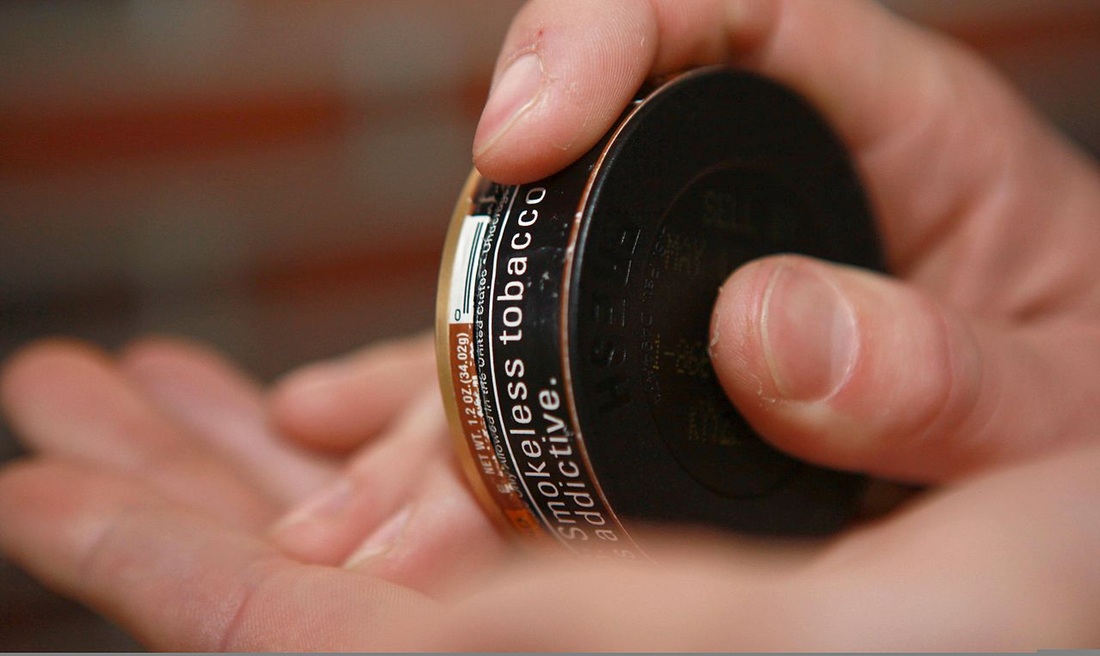|
Tobacco is well known for increasing a person's risk of developing cancer. And the same applies to smokeless tobacco. This type of tobacco comes in many forms, and although some people believe that it is safer to use than smokeable tobacco, it should be noted that no form of tobacco is healthy.
Some of the more common references that smokeless tobacco goes by include chew, spit, dip, and snuff. When people use this form of tobacco, they will commonly suck on it and then spit out any juices that form in their mouths. However, over the past several years, the popularity of "spitless" tobacco has increased, but it still has properties that increase a person's chances of developing cancer. From Asia to South and North America to Africa, smokeless tobacco is a substance that has been used by people all around the globe for thousands of years. The average amount of nicotine, which is the substance in smokeless tobacco that causes it to be addictive, is about 4.5 mg per pinch or dip of smokeless tobacco. Compared to a normal cigarette, this is over twice the amount. It would take 60 cigarettes to equal the amount of nicotine found in a can of dip. Statistics about Smokeless Tobacco More than 2.5 billion dollars each year in the United States (US) are spent by consumers on smokeless tobacco products. About 10 million people living in the US use smokeless tobacco. Approximately three percent of males and one percent of females use this type of tobacco. Although smokeless tobacco is not widely used by students in college, of those that do, about 16 percent are college athletes; this is probably largely due to the fact that most of them are prohibited from using other forms of tobacco. In regards to people who are under the age of 21, in the US, about 3 million use smokeless tobacco, with 75 percent of those people having used this type of tobacco before they reached 15 years of age. In the US alone, more than 7,500 people die each year as a result of using smokeless tobacco. 75% of these people died due to the development of any of the following forms of cancer:
There are 28 carcinogens in smokeless tobacco that are known to cause cancer. If a person uses smokeless tobacco, he or she increases his or her chances of developing cancer by 50 percent. Users have a 40 to 60 percent chance of developing Leukplakia, with a two to six percent chance that the Leukplakia will turn into cancer. When a person suffers from Leukplakia, there will be white patches, which tend to be thick, that cover the tongue as well as the person's cheeks. The most common cause of this condition is tobacco. Two Main Types of Smokeless Tobacco Chewing tobacco and snuff are the two primary forms of smokeless tobacco. Chewing tobacco tends to come in leaf form; however, sometimes it has the appearance of rope. When using this type of smokeless tobacco, it is placed between a user's cheek and his or her lower lip. Most times, people will place it toward the back of their mouths, but this isn't always true. A user can then decide for himself or herself whether to spit or swallow the juices that are created by sucking on the tobacco. Snuff is the opposite of chewing tobacco in that the leaves are finely cut. Sometimes, they are so finely cut that they come in powder form. This form of smokeless tobacco is available in a wide array of flavors and scents. People who use it have the option of buying it either moist or dry. They also have the choice of buying it in small tea bags, which are placed between the cheek and gums. Understanding the Harmful Chemicals in Smokeless Tobacco As stated before, there are 28 chemicals in smokeless tobacco that are known to cause cancer. Of these substances, the most dangerous tend to be nitrosamines. Nitrosamines are formed during the following stages of tobacco production:
Some forms of smokeless tobacco contain higher amounts of nitrosamines, and studies have indicated that higher amounts are a major contributor to the development of cancer. Two other primary chemicals found in smokeless tobacco that significantly influence a person's chances of developing cancer are polonium-210 and polynuclear aromatic hydrocarbons. Is Smokeless Tobacco Worse than Smokeable Tobacco? It should be noted that both forms of tobacco can lead to cancer. However, at the same time, it should be remembered that the nicotine found in smokeless tobacco stays in the bloodstream of users longer than that of those who smoke tobacco. Then again, the exact amount of nicotine is largely dependent on the amount of smokeless tobacco used as well as the product's pH. Using Smokeless Tobacco On a Safe Basis Never should a person be fooled into believing that there is a safe way to use smokeless tobacco. In fact, anyone who uses any type of tobacco product should be highly encouraged to quit. Millions of people who use tobacco have found great success in quitting. On the other side of the fence, if a person is adamant about using smokeless tobacco, the less he or she uses, the better. Smoking Bans Have Likely Increased the Use of Smokeless Tobacco In the US, the implementation of smoking bans has likely increased the use of smokeless tobacco. In fact, it is because of these bans that many tobacco companies have taken it upon themselves to increase their marketing efforts for smokeless tobacco. These companies are now advertising smokeless tobacco as an excellent alternative to tobacco products that get smoked—cigarettes and cigars. Many people who are used to smoking cigarettes or cigars in public places are now turning to smokeless tobacco because they can use these products in places where cigarettes are now banned. Studies are showing that the efforts of tobacco companies to promote smokeless tobacco are proving effective, and this is especially seen in young adults. And to top things off, many users of tobacco are now using both forms—smokeable and smokeless tobacco—doubling their risk of developing cancer and heart disease. The Effects of Smokeless Tobacco There are many harmful effects that tend to result from the use of smokeless tobacco, with the most common being the following:
Further Readings http://www.thequit.org/tools-resources/facts-statistics/chewing-tobacco-statistics/ http://www.cancer.org/cancer/cancercauses/tobaccocancer/smokeless-tobacco http://www.medpagetoday.com/Pulmonology/Smoking/15292
0 Comments
 In the year 2012, there were more than 120,000 writers and authors in the United States. Keeping this statistic in mind, it's safe to assume that I'm not the only person who suffers from back and shoulder pain as a result of sitting behind a computer screen all day. Sure, lots of people think that my job is heaven-sent because I'm literally provided with all the freedom in the world to complete my work as I please, but when it comes to reality, most of my work is completed sitting behind a desk, staring at a computer screen, which results in many different types of pain. Over the past few days, I've thought to myself, 'Surely there's got to be a better way to deal with pain!' If you happen to spend your days sitting behind a desk, typing away on a keyboard, and/or completing paperwork, here are a couple back pain treatment tips that are sure to make your life a bit more comfortable. Dish Out the Money for a Comfortable Chair An ergonomic chair that promotes good posture can go a long way toward reducing the pain endured from sitting behind a desk all day. Even better is the fact that these chairs don't cost an arm and a leg. They are going to be a bit more expensive than average desk chairs, but being that they promote good posture, your money will be well invested. Best of all, you can usually find ergonomic chairs at consignment shops and flea markets for well under the price they normally sell for. It wasn't too long ago that I found an ergonomic chair for $25 at a local peddler's mall. A Daily Dose of Exercise Goes a Long Way It was only two years ago that I weighed 119 pounds. Nowadays, though, I tend to maintain a weight level of about 140 lbs. Why in the world did I gain so much weight? I’ll tell you why. It’s because over the past two years, my freelance writing business has really started to explode, and I’ve found myself sitting behind my desk much more often than I used to. As a result, I’ve quit being as active as I used to be. Over the past couple of months, though, I’ve started walking 20 minutes a day on the treadmill. Since then, I’ve dropped about 10 pounds, and I’ve noticed my back and shoulder pain have greatly reduced. Keeping this in mind, it’s easy for me to assume that my daily workout is going a long way toward reducing the pain associated with sitting behind a desk. You should do the same. All it takes is 20 minutes a day. The Pain Can Get Better If you suffer from pain because you sit behind a desk all day, there’s great news! Relieving the pain is possible, and best of all, you can reduce your pain without visiting a doctor. But keep in mind that if your pain worsens, visiting a doctor who specializes in pain will be a smart move to make. Down here in the sticks of the Bluegrass State, we country folks sure do love getting muddy and going off-road in our jacked-up diesel trucks. Many times, though, we take things a little too far and find ourselves stuck. We also tend to mess things up on our trucks. But that's not a problem because we have a diesel mechanic here in my area who does top-notch work on diesel vehicles.
Regardless of your age, if you have a desire to work on diesel engines, it's never too late to establish a career in this line of work. Best of all, this is a job that tends to pay quite well and is accompanied by a high level of job stability. There are several steps that you'll need to complete before earning the legitimate title of diesel mechanic in Kentucky. Sure, without following these steps, you can open your own shop and perform a variety of diesel-related tasks, but you won't be able to acquire insurance for your shop, nor will you be able to attract a lot of customers. Gain Experience As soon as you decide you want to become a diesel mechanic in Kentucky, it'll be beneficial to secure a job at a local diesel shop. Even if you're only running the cash register or sweeping the shop's floor, any and all experience will be beneficial. Go to School You don't have to go to an actual college or university to become a diesel mechanic, but vocational training is required. Keep in mind that working on diesel engines is much different than working on gas engines, and because of this, diesel mechanic programs are not the same as regular mechanic curricula. The average diesel mechanic program tends to be about two to three years in length. Most programs also come with job placement help, which can be of the utmost value once you graduate. Get Your Licensure Once you graduate from your post-secondary training program, you'll then have to acquire your licensure. Most licensure programs require you to pay a fee and pass an exam. Part of the exam will likely be hands-on, while the other part will be a multiple-choice test. Land a Job Hopefully, the school that you complete your training at will offer a job placement program. As a result, you'll already have a job lined up once you graduate. If the school doesn't offer job placement, you'll have to search for a job yourself, but there's no need to fret. Diesel mechanics in Kentucky tend to be in high demand due to the extensive training and knowledge that they must possess, so it shouldn't be hard for you to find a job. The Takeaway Becoming a diesel mechanic does take quite a bit of training and requires lots of experience, but it's definitely a career field you should look into if you like working on diesel engines.  When was the last time you thought about all of the technologies being created these days? More importantly, have you wondered how such advancements can benefit your business? If not, it's time to slow down your pace and take a moment to laser-focus on all that technology has to offer you. Some of the primary advantages you can gain by leveraging today's latest technologies include:
Here are two of today's most highly successful companies that are producing and using technology to the max. Your business can do the same! Intellect Enterprises Intellect Enterprises is a wholly owned subsidiary of Intellect, a trade association in the United Kingdom for the IT, telecommunications, and electronics industries. It is an ISO9001-certified company certified by the British Assessment Bureau that provides copyright protection, source code validation, and software escrow services. With copyright protection, a date- and time-stamped copy of the client’s original materials (artwork, fashion designs, music scores, software applications, and Web sites) can be stored. In the event of a copyright dispute, Intellect Enterprises’ proprietary software provides the needed proof regarding the original creation date and time. Due to the proof, competitors are not able to state that their company created the software first. Source code validation ensures that the source code and related materials deposited into escrow will produce the software that the end user expects them to produce. Intellect Enterprises affirms that the source code in escrow is usable for the stated purposes, indicates what skills are needed to use the software, and provides confirmation that all required documentation is present. Software escrow provides source code protection for both users and software developers and guarantees access to a software application’s source code if a release event should occur. Having a company’s software protected by escrow ensures the continuity of the business should an unforeseen catastrophic event occur within the company’s physical infrastructure. Hacking Team Valeriano Bedeschi and David Vincenzetti founded Hacking Team in Milan, Italy, in 2003. The company, which received venture capital funding in 2007, provides software technology to intelligence communities and law enforcement agencies worldwide, enabling those entities to be on the offensive rather than the defensive. Encryption is widely employed in modern digital communications as a means of protecting users from eavesdropping. It prevents intelligence and law enforcement agencies from monitoring individuals and groups in order to prevent threats to a country’s security and crimes from occurring. Hacking Team, which states the company employs less than 75 people, has developed a remote control system (RCS). This product's design evades encryption through the use of an agent installed directly on the device to be monitored. The information that is collected on monitored devices is collected by stealth methods. Transmission of the collected data from the device being monitored to the Remote Control System server is untraceable and encrypted. Hacking Team does not sell its RCS product to private businesses or individuals. The company’s only customers are government agencies. Hacking Team will not sell its software to agencies or governments suspected of human rights violations, to those governments, or to countries blacklisted by the United States, European Union, United Nations, NATO, or ASEAN. The Takeaway As you can clearly see, technology is advancing at a rapid rate, and if your business doesn't start to take advantage of it, you may find yourself closing your doors. Many of your competitors are already using advanced technology, and you need to too. Whether you're a small retail shop operating on the Pacific Coast or a government agency working undercover to take down methamphetamine manufacturers in the Bluegrass State, it's time to put your money where it needs to be—technology that works! Thanks, Marlene, for your help with this posting! |


